This can be broken down into two parts.
- Use
GSON to parse a JSON Array to an Array of POJOs.
- Display a
List of Objets in a TableView.
Key Code
//Add data to the TableView!
String jsonString = "[{\"keyOne\":\"1\", \"keyTwo\":\"2\"}, {\"keyOne\":\"3\", \"keyTwo\":\"4\"}]";
Gson gson = new Gson();
Data[] dataList = gson.fromJson(jsonString, Data[].class);
ObservableList<Data> observableList = FXCollections.observableArrayList(dataList);
tableView.setItems(observableList);
Main
import com.google.gson.Gson;
import javafx.application.Application;
import javafx.beans.property.SimpleStringProperty;
import javafx.collections.FXCollections;
import javafx.collections.ObservableList;
import javafx.scene.Scene;
import javafx.scene.control.TableColumn;
import javafx.scene.control.TableView;
import javafx.stage.Stage;
import javafx.scene.layout.StackPane;
public class App extends Application {
public static void main(String[] args) {
launch(args);
}
@Override
public void start(Stage stage){
TableView<Data> tableView = new TableView();
TableColumn<Data, String> column1 = new TableColumn<>("Key One");
column1.setCellValueFactory((cdf) -> new SimpleStringProperty(cdf.getValue().getKeyOne()));
TableColumn<Data, String> column2 = new TableColumn<>("Key Two");
column2.setCellValueFactory((cdf) -> new SimpleStringProperty(cdf.getValue().getKeyTwo()));
tableView.getColumns().add(column1);
tableView.getColumns().add(column2);
//Add data to the TableView!
String jsonString = "[{\"keyOne\":\"1\", \"keyTwo\":\"2\"}, {\"keyOne\":\"3\", \"keyTwo\":\"4\"}]";
Gson gson = new Gson();
Data[] dataList = gson.fromJson(jsonString, Data[].class);
ObservableList<Data> observableList = FXCollections.observableArrayList(dataList);
tableView.setItems(observableList);
Scene scene = new Scene(new StackPane(tableView));
stage.setTitle("JavaFX 13");
stage.setScene(scene);
stage.show();
}
}
Data Class
/**
*
* @author sedj601
*/
public class Data {
private String keyOne;
private String keyTwo;
public Data(String keyOne, String keyTwo) {
this.keyOne = keyOne;
this.keyTwo = keyTwo;
}
public String getKeyOne() {
return keyOne;
}
public void setKeyOne(String keyOne) {
this.keyOne = keyOne;
}
public String getKeyTwo() {
return keyTwo;
}
public void setKeyTwo(String keyTwo) {
this.keyTwo = keyTwo;
}
@Override
public String toString() {
StringBuilder sb = new StringBuilder();
sb.append("Data{keyOne=").append(keyOne);
sb.append(", keyTwo=").append(keyTwo);
sb.append('}');
return sb.toString();
}
}
module-info.java
module com.mycompany.javafx_test_2 {
requires javafx.controls;
exports com.mycompany.javafx_test_2;
opens com.mycompany.javafx_test_2 to com.google.gson;
requires com.google.gson;
}
Using GSON version 2.8.9.
Output

